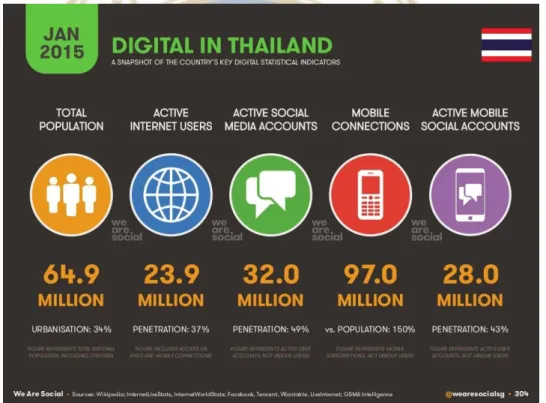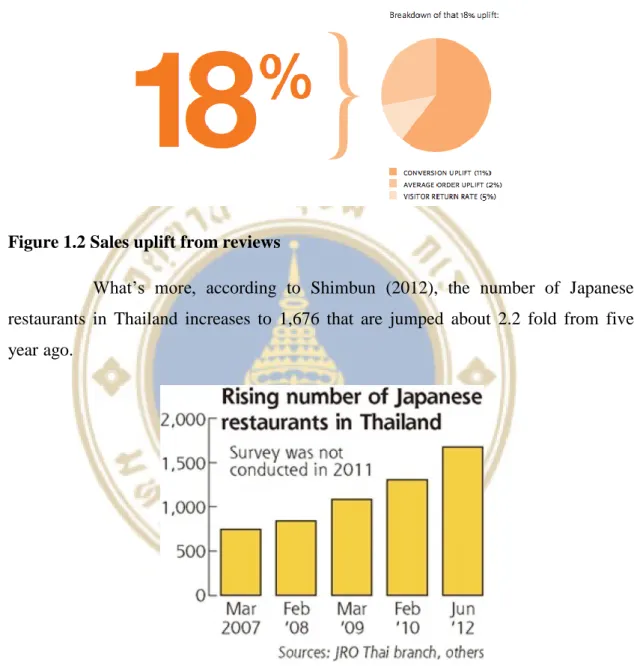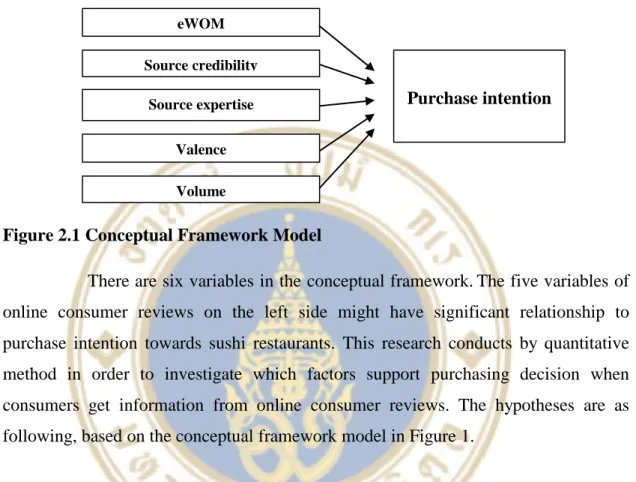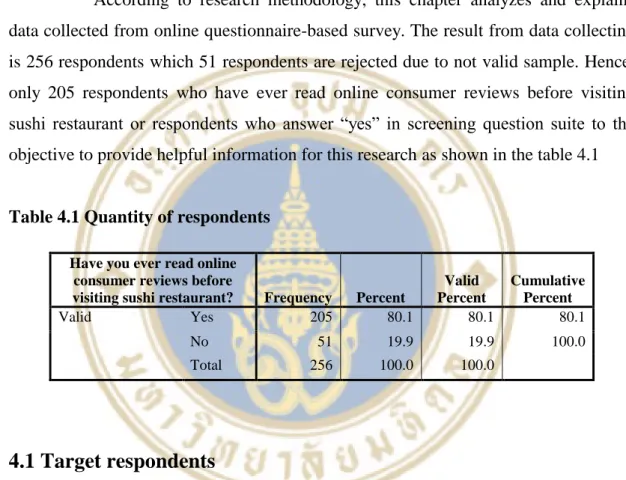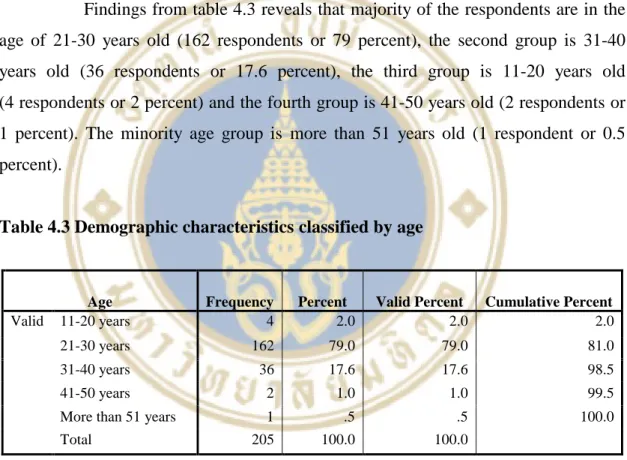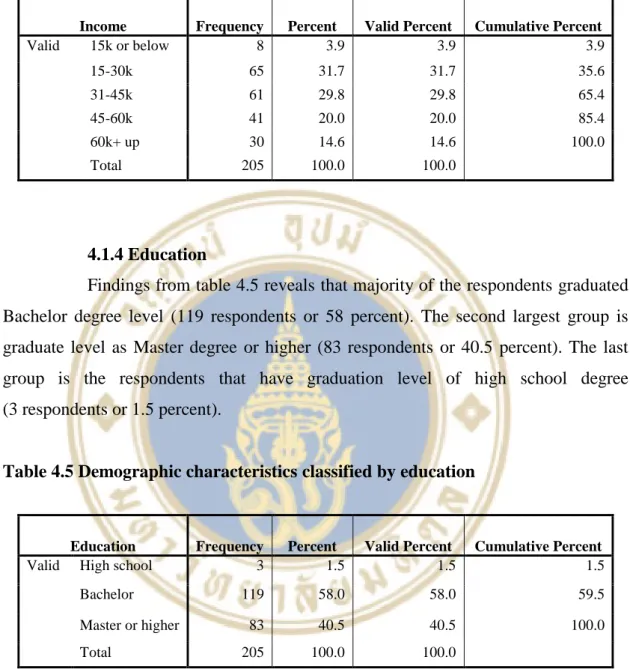Therefore, this study aims to find out the effect of online consumer review on purchase intention of sushi restaurant in Thailand. In Thailand, the number of Sushi restaurants and Sushi bars has been rapidly established in populated areas.

Research problem
The development of sushi has stated that a few sushi restaurants have been established in the US, and American has modified the taste of sushi rice to be sweeter, which is called American sushi and later also popular in Japan. Especially in Bangkok there are many popular sushi restaurants such as Mugendai, Isao, Sushi Masa and Sushi Hiro.
Research objectives
In the beginning, sushi was not a prestigious food as it is today and it is a kind of fast food sold by the harbor. Some restaurants import ingredients from Japan; therefore, the taste and quality of the food is probably the same as the origin.
Research questions
LITERATURE REVIEW
Theoretical foundations
- eWOM (Electronic word‐of‐mouth)
- Source credibility
- Source expertise
- Valence
- Volume
Message source credibility refers to the level of the receiver's belief in the message of the sender (Paul C.S. Wu Yun-Chen Wang, 2011). As a result, the receivers engage with the message only when they feel it is necessary, therefore it is plausible that the source knowledge is essential for the purchase of specific products by consumers.
Previous empirical studies
- The influence of online reviews to online hotel booking intentions From previous study, Xinyuan (Roy) Zhao et al.,(2015) find out that
- Impact of online reviews of customer care experience on brand or company selection
- The impact of online user reviews on cameras sales
This finding is also consistent with the research conducted by Johnson and Kayne (2004) that studies the impact of blogs which the social-based websites are reliable due to free opinion sharing and assumed to be unbiased. On the contrary, there is no impact of consumer review for the websites, which consist of government information websites, company websites and search engines on the customer's purchase intention. Moreover, this is consistent with the previous research conducted by Bickart and Schindler (2001), which revealed that consumers who gather information from online discussions would be more interested in product than getting information from marketer-generated sources due to the trust issue, as also mentioned in a study by Sen (2008).
Cartwright, (2013), the purpose of this research is to understand the impact of online user reviews on sales of search goods, the thing that customers do not need interaction to evaluate product choices, such as camera (Nelson. The research shows that online user reviews, average online customer review rating and the volume of user reviews have the significant relationship and influence purchase decisions as well as sales of search goods.
Conceptual framework
RESEARCH METHODOLOGY
- Research design
- Sample selection
- Survey instrument
- Screening question To select target respondents who have direct experience with reading online consumer reviews and deciding to go to sushi
- General questions The questions ask for getting the respondents’
- Specific questions The questions are related to previous literature review and conceptual framework. There are different scales from number 1-5 with
- Data collection
- Data analysis
In this study, the researcher uses non-probability sampling method which is more convenient due to time constraint. The target sample of this research is respondents who have ever read online consumer reviews before visiting a sushi restaurant because they have direct experience with what the researcher will be studying. Therefore, the first part of the questionnaire contains a screening question that reads: "Have you ever read online consumer reviews before visiting a sushi restaurant?" to select a valid sample from among other respondents who are suitable for participation in the research.
Screening Question To select target respondents who have direct experience reading online customer reviews and deciding to go to sushi experience reading online customer reviews and deciding to go to a sushi restaurant, who are valid sample suitable to participate in this study. In addition, this section shows the behavior of consumers regarding how they read online consumer reviews before visiting the sushi restaurant. The target sample is people who read consumer reviews online and go to sushi restaurant and the sample size of this study is at least 200 respondents.
Multiple regression analysis is used to assess the relationship between an outcome variable that is the response or dependent variable and risk factors that are explanatory or independent variables. In this analysis, the dependent variable is denoted by "y" and the independent variables are denoted by "x".
FINDINGS AND DATA ANALYSIS
Target respondents
- Gender
- Monthly Income
- Education
Findings from Table 4.5 show that the majority of respondents obtained a bachelor's degree (119 respondents or 58 percent). The second largest group has a master's degree or higher (83 respondents or 40.5 percent).

Behaviors
- Frequency of reading online consumer reviews about sushi restaurant
- Main purpose for searching sushi restaurant’s information From table 4.7, the result shows most of respondents search for sushi
- Frequency of eating sushi food
From Table 4.6, the result shows that the majority of respondents read online consumer reviews about sushi restaurants 2-3 times a month, about 62 respondents or 30.2 percent. The second is the amount and percentage of respondents who read online consumer reviews about sushi restaurants once a month and less than once a month, which is the same with each 54 respondents or 26.3 percent. From table 4.8, the result shows that 79 respondents or 38.5 percent eat sushi food 2-3 times a month is the majority of the respondents.
Second and third are the respondents who eat sushi food once a month and less than once a month with 66 respondents or 32.2 percent and 34 respondents or 16.6 percent respectively.
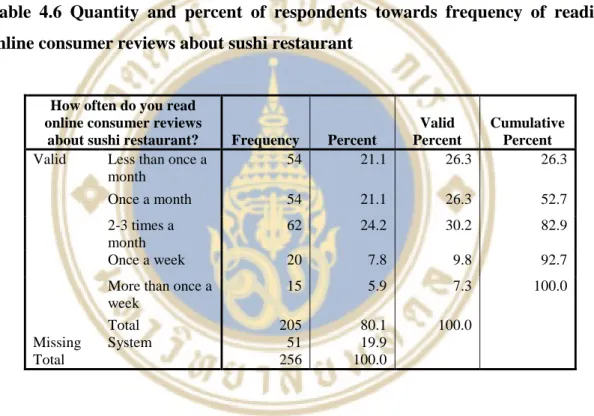
Hypothesis testing
- Descriptive statistics
- Crosstabs analysis
- Correlations Analysis
- Multiple regression analysis
As shown in table 4.12, most respondents in all education levels usually get information from friend and online/website/blogger, but there is only high school level that get information from family, TV and magazine. As shown in table 4.13, all groups of respondents mostly collect information online from Wongnai and Pantip rather than other websites. From Correlation analysis as shown in table 4.14, the result shows correlations between factors as follows;.
SPSS results emerge from multiple regression analyzes demonstrating the relationship between objective factors of online consumer reviews and purchase intention at a sushi restaurant. The result of the multiple regression analysis indicates one of the subjective and five objective factors that significantly influence the consumer's purchase intention in a sushi restaurant with a p-value of the F-test of less than 0.05 (p<0.05) . This may indicate that EWOM, source credibility, source expertise, valence, and volume variables can explain 76.9 percent of the consumer purchase intention variable, implying that this model has high predictive power.
From Table 4.16, the ANOVA result of the regression analysis shows that at least one of the five factors (EWOM, source credibility, source expertise, valence and volume) is statistically significant in influencing purchase intention at a sushi restaurant with the p- value of the F-test less than 0.05 (F p-value = 0.000). Predictors: (constant), volume, valence, source expertise, source credibility, EWOM. t = 5.120, p-value = 0.000) are significant explanatory variables in predicting customers' purchase intention (Y).
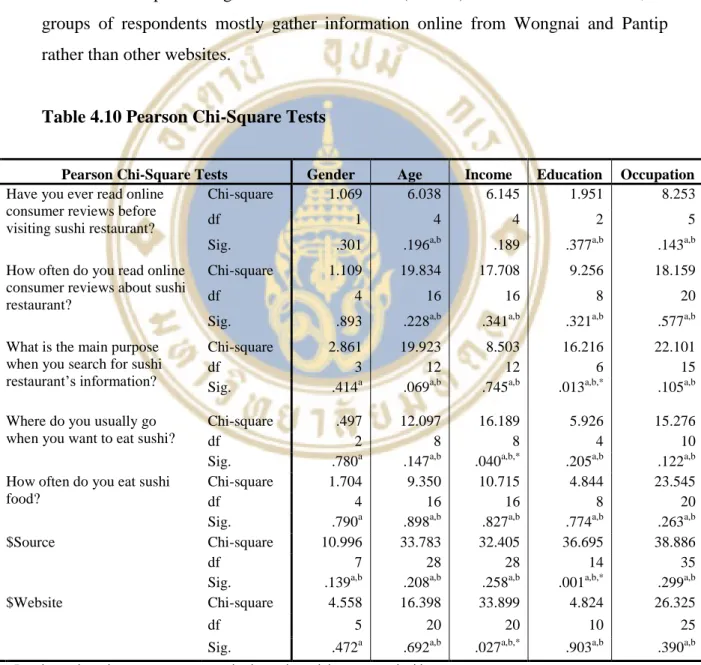
CONCLUSION AND RECOMMENDATION
- Conclusion
- Recommendations
- Limitation
- Further research
After reviewing literature review and analyzing research results, it was concluded that EWOM, source credibility and volume of online consumer reviews are important factors influencing consumers' purchase intention. Therefore, sushi restaurant owners should track and monitor both positive and negative statements, especially through online consumer reviews, as this type of information is useful for restaurants to get customer feedback in a direct way. On the other hand, on the negative side, sushi restaurants should reach out to apologize to the reviewers and try to negotiate so that they will remove that post as soon as possible because negative statements can influence the customer's decision not to go to the restaurants to go to.
Moreover, they should improve themselves and find solutions to solve the problem to increase customer satisfaction and prevent bad image of restaurants. Regarding the source credibility and the amount of reviews, the result reveals that Pantip and Wongnai are the most popular websites that consumers like to visit. Therefore, this research will suggest that sushi restaurants hire the consumers who are known reviewers and always visit many restaurants to write and share the reviews via Pantip and Wongnai, leading to increasing number of online consumer reviews in the right channels.
The sample size should be larger to obtain different results and represent the entire population. In addition, this study could be an idea about the impact of consumer reviews on other companies.
1994), “A knowledge model of persuasion: how people cope with persuasion attempts”, Journal of Consumer Research, Vol. 2004), “Using online conversations to study word-of-mouth communication”, Marketing Science, Vol. 2006), “Measuring online review-seeking motivation”, Journal of Interactive Advertising, Vol. Ecommerce Consumer Reviews: Why You Need Them and How to Use Them.” Retrieved from https://econsultancy.com/blog/9366-ecommerce-consumer -reviews-why-you-need-them-and-how-to- them-them/. 2006), "eWOM: The Impact of Customer Knowledge Sharing on Customer Value and Loyalty", Journal of Business Research, Vol. 2001), "Measuring Word-of-Mouth Communication and Investigating Service Quality and Customer Commitment as Potential Antecedents", Journal of Service Research , Vol. 2003), "Electronic Word of Mouth: Motives and Consequences of Reading Customer Testimonials on the Internet", International Journal of Electronic Commerce, Vol. 2004), "Electronic Word of Mouth via a Consumer Opinion Platform: What Motivates Consumers , to express themselves on the Internet?", Journal of Interactive Marketing, Vol. 1991), "The Effects of Word of Mouth and Product Attributes on Persuasion: An Accessibility Diagnostics Perspective", Journal of Consumer Research, Vol. Joonhyuk Yang, Wonjoon Kim, Naveen Amblee, Jaeseung Jeong The heterogeneous effect of WOM on product sales: why is the effect of WOM valence mixed?", European Journal of Marketing, Vol. 1973), The Conduct of Inquiry, Intertext Books.
Cartwright The influence of online user reviews on camera sales", European Journal of Marketing, year 2008), "Understanding and persuasion in an advertising message: a heuristic-systematic model approach", Journal of Management, year 2001), "Social cognition: categorical perception of persons" , British Journal of Psychology, Vol. 1992), "The Brand as a Heuristic Cue: The Effects of Task Relevance and Expectancy Confirmation on Consumer Judgments", Journal of Consumer Psychology, Vol. 1970), "Information and Consumer Behavior", Journal of Political Economy, Vol. 1974), “Advertising as Information”, Journal of Political Economy, Vol. on Consumer Purchase Intentions: The Moderating Role of Involvement", International Journal of Electronic Commerce, Vol. Richard Buda, Yong Zhang Consumer Product Evaluation: The Interactive Effect of Message Framing, Presentation Order, and Source Credibility", Journal of Product & Brand Management, Vol. 1976), “Low-commitment consumer behavior”, Journal of Advertising Research, Vol. 1991), "A better advertising planning grid", Journal of Advertising Research, October/November, p. 2008), "Determinants of consumer trust of virtual word-of-mouth: an observation study from a retail web site", Journal of American Business Academy, vol. 2009), “Consumer skepticism and online reviews: an elaboration likelihood model perspective”, Social Behavior and Personality, Vol.
Xinyuan (Roy) Zhao, Liang Wang, Xiao Guo, Rob Law The influence of online reviews to online hotel booking intentions", International Journal of Contemporary Hospitality Management, bind 2009), "The impact of online user reviews on hotel room sales" , International Journal of Hospitality Management , Vol. Hentet fra http://www.nationmultimedia.com/business/Burgeoning- growth-of-Japanese-cuisine-in-Thailand-30190989.html. 1985), "Measuring the involvement construct" , Journal of Consumer Research, Vol.
APPENDICES
APPENDIX A Questionnaire
IMPACTS OF ONLINE CONSUMER REVIEWS ON PURCHASE INTENTION TOWARDS SUSHI RESTAURANTS
- Screening question
- General questions
- Specific questions
- Demographic questions 1. Please select your gender
I don't go to the sushi restaurant that has been awarded low stars by the reviewer. Sushi restaurant with many online consumer reviews confirm my opinion. Online consumer reviews influence my purchase intention to go to a sushi restaurant.

